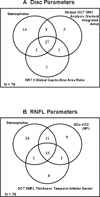Discrimination between glaucomatous and nonglaucomatous eyes using quantitative imaging devices and subjective optic nerve head assessment
- PMID: 16877405
- PMCID: PMC3882168
- DOI: 10.1167/iovs.05-1239
Discrimination between glaucomatous and nonglaucomatous eyes using quantitative imaging devices and subjective optic nerve head assessment
Abstract
Purpose: To compare the diagnostic ability of the confocal scanning laser ophthalmoscope (HRT-II; Heidelberg Engineering, Heidelberg, Germany), scanning laser polarimeter (GDx-VCC; Carl Zeiss Meditec, Inc., Dublin, CA), and optical coherence tomographer (StratusOCT, Carl Zeiss Meditec, Inc.) with subjective assessment of optic nerve head (ONH) stereophotographs in discriminating glaucomatous from nonglaucomatous eyes.
Methods: Data from 79 glaucomatous and 149 normal eyes of 228 subjects were included in the analysis. Three independent graders evaluated ONH stereophotographs. Receiver operating characteristic curves were constructed for each technique and sensitivity was estimated at 80% of specificity. Comparisons of areas under these curves (aROC) and agreement (kappa) were determined between stereophoto grading and best parameter from each technique.
Results: Stereophotograph grading had the largest aROC and sensitivity (0.903, 77.22%) in comparison with the best parameter from each technique: HRT-II global cup-to-disc area ratio (0.861, 75.95%); GDx-VCC Nerve Fiber Indicator (NFI; 0.836, 68.35%); and StratusOCT retinal nerve fiber layer (RNFL) thickness (0.844, 69.62%), ONH vertical integrated rim area (VIRA; 0.854, 73.42%), and macular thickness (0.815, 67.09%). The kappa between photograph grading and imaging parameters was 0.71 for StratusOCT-VIRA, 0.57 for HRT-II cup-to-disc area ratio, 0.51 for GDX-VCC NFI, 0.33 for StratusOCT RNFL, and 0.28 for StratusOCT macular thickness.
Conclusions: Similar diagnostic ability was found for all imaging techniques, but none demonstrated superiority to subjective assessment of the ONH. Agreement between disease classification with subjective assessment of ONH and imaging techniques was greater for techniques that evaluate ONH topography than with techniques that evaluate RNFL parameters. A combination of subjective ONH evaluation with RNFL parameters provides additive information, may have clinical impact, and deserves to be considered in the design of future studies comparing objective techniques with subjective evaluation by general eye care providers.
Figures


References
-
- Zangwill LM, Bowd C, Berry CC, et al. Discriminating between normal and glaucomatous eyes using the Heidelberg Retina Tomograph, GDx Nerve Fiber Analyzer, and Optical Coherence Tomograph. Arch Ophthalmol. 2001;119:985–993. - PubMed
-
- Wollstein G, Garway-Heath DF, Fontana L, Hitchings RA. Identifying early glaucomatous changes: comparison between expert clinical assessment of optic disc photographs and confocal scanning ophthalmoscopy. Ophthalmology. 2000;107:2272–2277. - PubMed
-
- Greaney MJ, Hoffman DC, Garway-Heath DF, et al. Comparison of optic nerve imaging methods to distinguish normal eyes from those with glaucoma. Invest Ophthalmol Vis Sci. 2002;43:140–145. - PubMed
-
- Miglior S, Guareschi M, Albe E, et al. Detection of glaucomatous visual field changes using the Moorfields regression analysis of the Heidelberg retina tomograph. Am J Ophthalmol. 2003;136:26–33. - PubMed
-
- Kanamori A, Nagai-Kusuhara A, Escano MF, et al. Comparison of confocal scanning laser ophthalmoscopy, scanning laser polarimetry and optical coherence tomography to discriminate ocular hypertension and glaucoma at an early stage. Graefes Arch Clin Exp Ophthalmol. 2006;244:58–68. - PubMed
Publication types
MeSH terms
Grants and funding
LinkOut - more resources
Full Text Sources
Medical

